Developing and engineering antibodies for diagnostics or therapeutics necessitates comprehensively characterizing an antigen-antibody interaction.
Biolayer interferometry (BLI) is a real-time analytical technique that dramatically accelerates antibody discovery. Information on critical attributes such as binding kinetics, affinity, and competitive binding to specific epitopes is crucial for identifying tag-free target molecules or ones with widely used tags.
Gator Bio’s BLI platforms and biosensors offer high-precision analysis, reliability, and ease of use compared to commonly used immunoassays, such as ELISA.
This article presents information on five types of biosensors, Anti-Human IgG Fc Gen II (HFCII), Anti-Mouse IgG Fc (MFC), Ni-NTA, Streptavidin (SA), and Flex Streptavidin (Flex SA), and Small Molecule Analysis Probes (SMAP,) from Gator Bio’s biosensor portfolio.
These biosensors can significantly enhance throughput for characterizing antigen-antibody interactions and quantitating proteins and small molecules. Thus, antibody discovery can be advanced by the application of these biosensors.
Biosensor features
- Precoated and ready to use
- Enhanced sensitivity and reduced nonspecific binding
- Can be used for quantitation, kinetics, and epitope binning with BLI technology
- Suitable for a vast array of sample types, including crude and purified proteins
- Broad pH stability
- Can be regenerated or reactivated
- Samples can be reused among different biosensors
Schematic of a kinetics assay
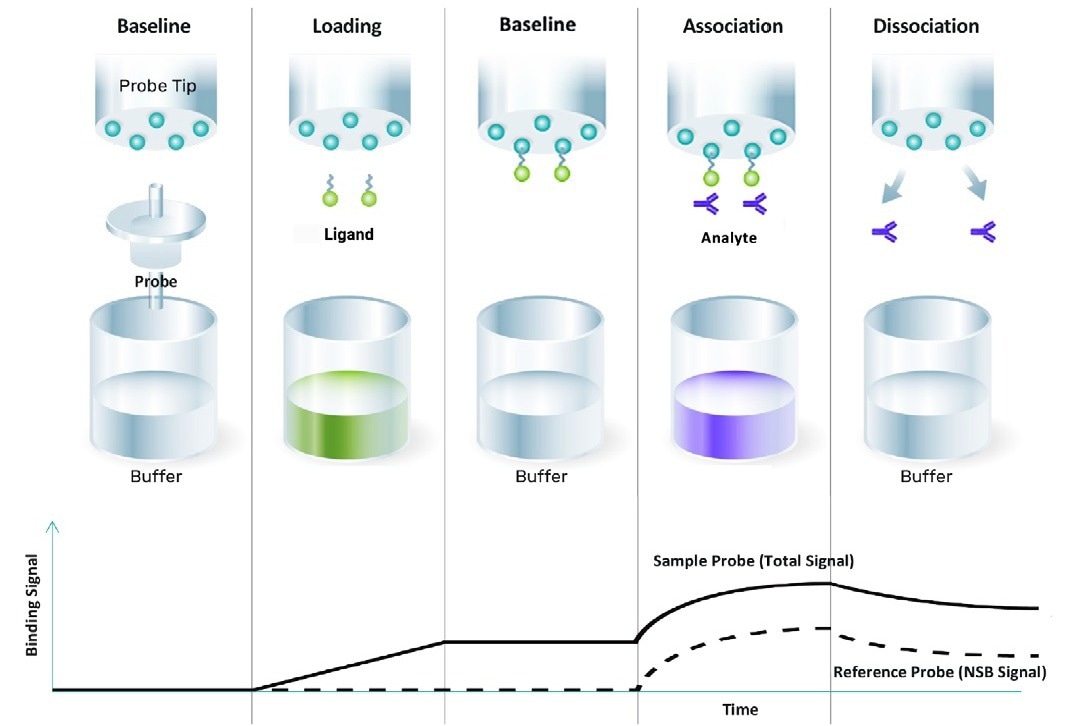
Figure 1. Overview of a kinetics assay workflow and sensogram with BLI technology. Real-time measurements are recorded as the change in the wavelength of reflected light returning from the optical biosensor surface. First, Gator® precoated biosensors are equilibrated by dipping into wells containing the assay buffer. In the ligand loading step, biosensors are dipped into wells containing the antigen. After a wash, the ligand-loaded biosensors are placed into wells containing the analyte, and an association or binding signal is measured. After another dip into wells containing the assay buffer, the ligand dissociates from the precoated biosensors. From the GatorOne analysis software, the association constant (kon), the dissociation constant (koff), and the KD and affinity values are obtained. Image Credit: Gator Bio, Inc.
Anti-Human IgG Fc Gen II biosensor
This biosensor is a high-performance HFCII biosensor that detects all four human IgG isotypes. It possesses an enhanced dynamic range for quantitation, a more stable baseline for measuring kinetics, and enhanced regeneration capabilities.
Significant improvements in throughput, productivity, real-time kinetics, and quantitation accuracy facilitate faster lead selection from antibody screening.
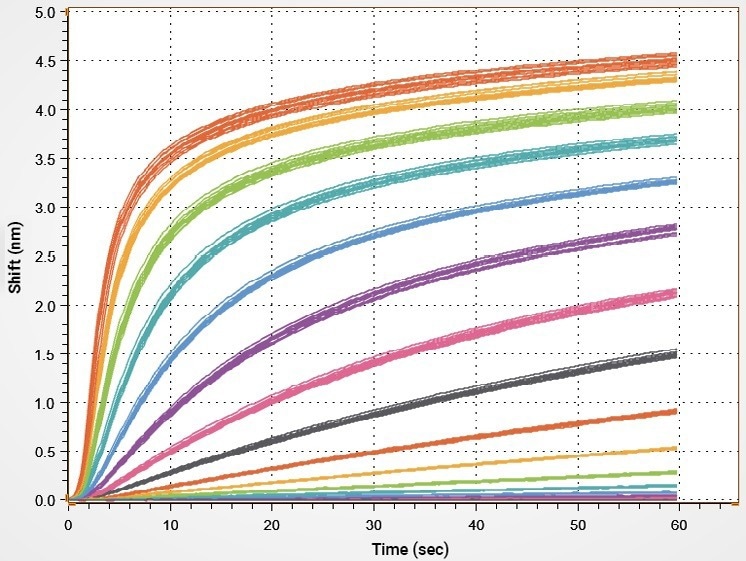
Figure 2. Quantitation of human IgG with concentrations ranging from 0.3 - 6000 μg/mL using Gator® HFCII biosensors. Image Credit: Gator Bio, Inc.
Table 1. Performance summary of Gator® HFCII biosensors in Quantitation (Q) and Kinetics (K) Buffer, and media). Source: Gator Bio, Inc.

Table 2. Regneration performance of Gator® HFCII biosensors. Kinetics parameters for anti-receptor binding domain (RBD) IgG1 and RBD protein for over 20 regeneration cycles. koff, kon, and KD values are within 20x folds of each other. Source: Gator Bio, Inc.

Anti-Mouse IgG Fc biosensor
Gator Bio’s MFC biosensor can detect antibody concentrations of 0.02 – 2000 μg/mL. This expands the dynamic range of the biosensor for rapid screening and antibody discovery without dilution steps. There is no compromise in data quality and greatly enhanced sensitivity, providing significant cost savings and faster results.
Gator® next-gen biosensor maintains high sensitivity and reproducibility even after ten regenerations, further enhancing the cost-effectiveness of this solution.
Table 3. Performance at a glance. Source: Gator Bio, Inc.


Figure 3. Reproducibility after 10 regenerations using MFC biosensors and a serial dilution of mouse IgG standards from 0.01 - 10 μg/mL. Image Credit: Gator Bio, Inc.
Ni-NTA biosensor
The Ni-NTA sensor from Gator Bio is functionalized with QiagenTM Tris-NTA and charged with Ni2+ ions for high-affinity immobilization of His-tagged proteins. No Ni2+ recharging step is needed using Ni-NTA Regen and Neutral Buffers.
Stable immobilization of His-tagged proteins allows throughput kinetics and epitope binning of antibodies, enabling rapid and continuous quantification without needing Ni2+ recharging.
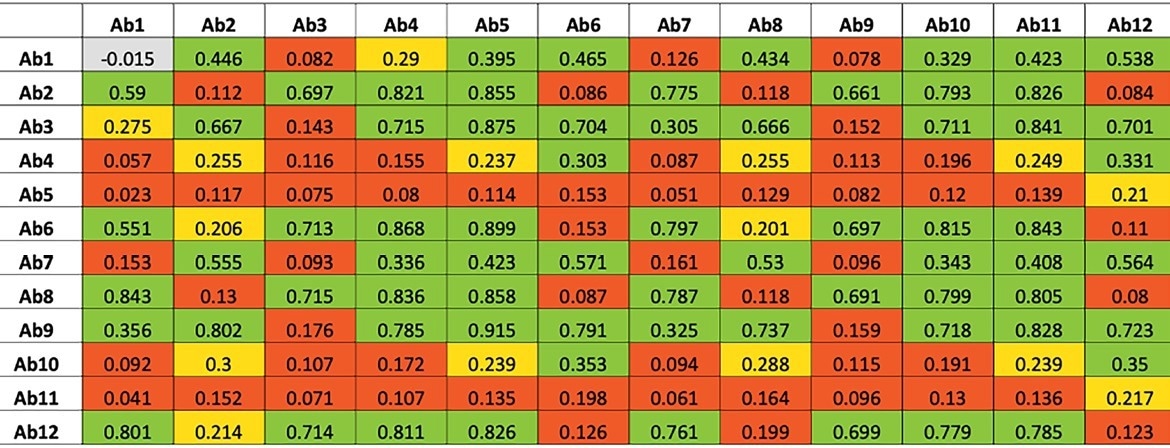
Figure 4. 12x12 antibody epitope binning assay using Ni-NTA biosensors for over 12 regenerations without the need for Ni2+ recharging. Red = Competition, Yellow = Ambiguous, and Green = Non-competition. Image Credit: Gator Bio, Inc.
Streptavidin (SA) and flex SA biosensors
These biosensors capture biotinylated proteins with a Molar coupling of <3 or proteins with AviTagTM. Gator® Flex SA is the first commercially available kit to provide reactivable streptavidin biosensors. This reusability makes it highly desirable for cost-effective research programs.
Biosensors can capture different biotinylated proteins after reactivation with no loss of performance.

Figure 5A-B. (A) Affinity measurement for protein-protein interactions. After a baseline measurement in Gator® K Buffer, biotinylated rabbit IgG was loaded onto SA biosensors, followed by an association and dissociation of an antigen from 0 – 500 nM. (B) Global-fit analysis using GatorOne software for antibody-antigen interaction, as seen in A. KD = 2.27 nM (r2 = 0.99) . Image Credit: Gator Bio, Inc.
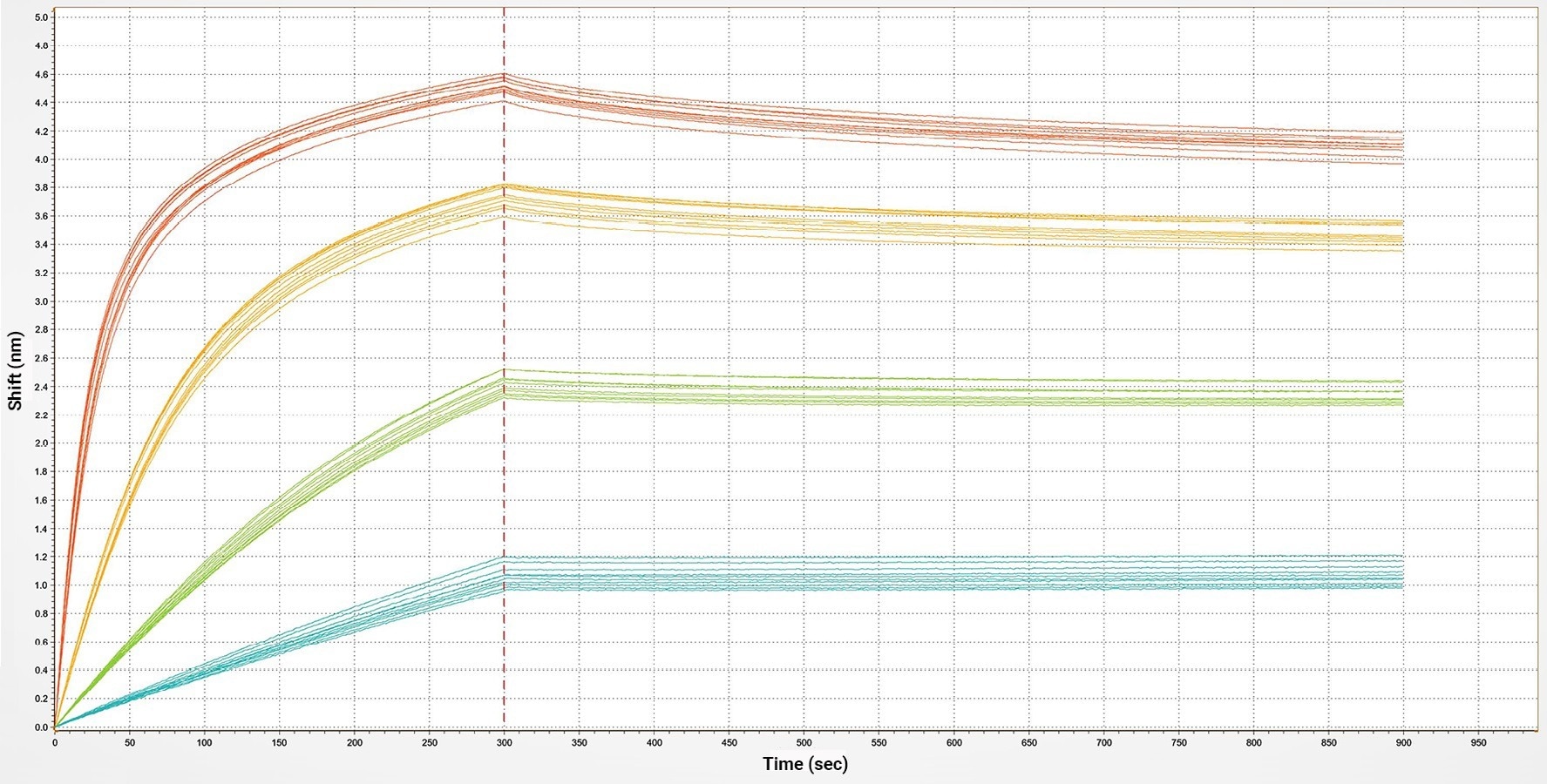
Figure 5C. Kinetics characterization of biotinylated tumor necrosis factor (TNF)-α and anti-TNF-α for over 10 reactivations using Flex SA biosensors. Image Credit: Gator Bio, Inc.
Table 4. KD measurements using the same set of Flex SA biosensors with two different kinetics pairs. The pairs were used alternatingly for over 10 reactivations. Source: Gator Bio, Inc.

SMAP biosensors
Gator Bio’s SMAP biosensors can capture small molecules (down to 150 Da,) biomolecules and peptides. They are highly sensitive with enhanced signal capabilities if needed and exhibit significantly improved performance with enhanced loading and global fit compared to conventional BLI biosensors.
Gator® sensograms exhibit clear binding signal and dissociation curves. These can be used to calculate Kon, Koff, and KD. Traditional BLI displays no clear signal.
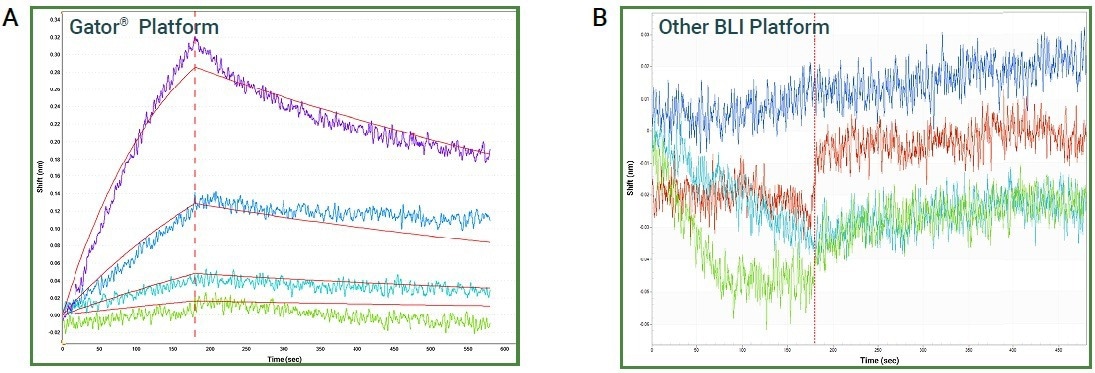
Figure 6A-B. Sensogram plots in a kinetics study comparing (A) SMAP biosensors on Gator Bio BLI platform versus (B) another BLI platform and their biosensors. Image Credit: Gator Bio, Inc.
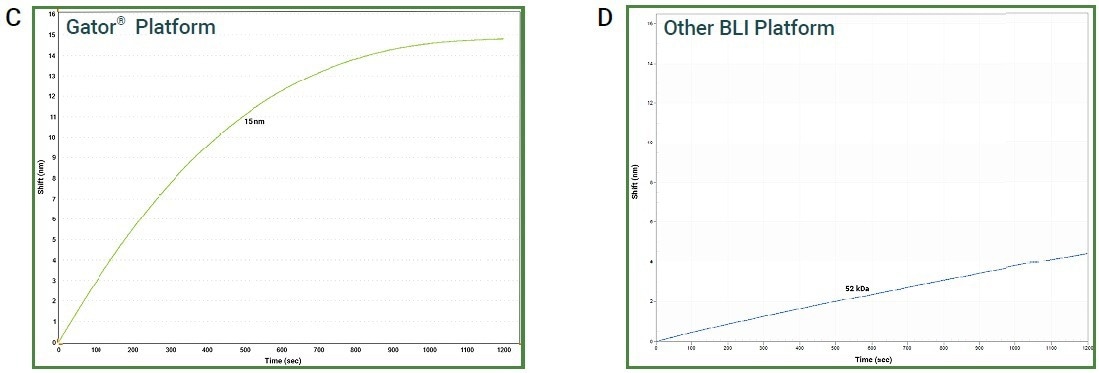
Figure 6C-D. Loading capacity of (C) SMAP biosensors on Gator Bio BLI platform versus (D) another BLI platform and their biosensors. Image Credit: Gator Bio, Inc.
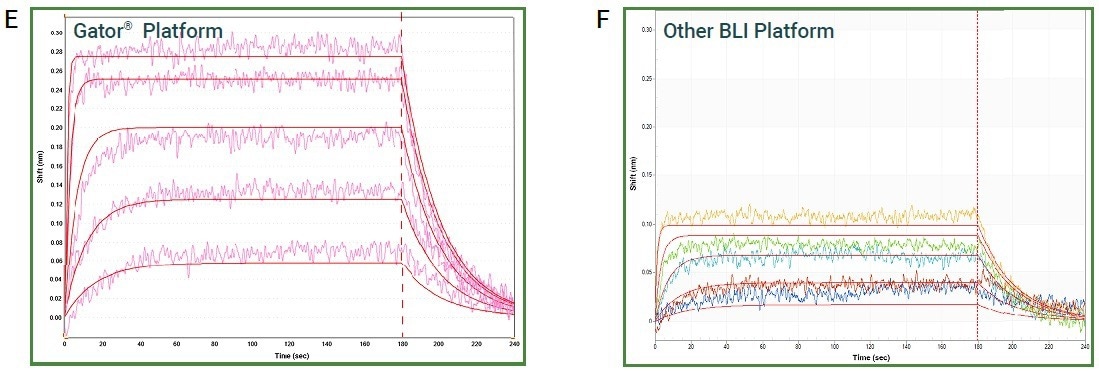
Figure 6E-F. Global-fit analyses comparing (E) SMAP biosensors on Gator Bio BLI platform versus (F) another BLI platform and their biosensors. Image Credit: Gator Bio, Inc.
Summary
Next-gen BLI biosensors and platforms from Gator Bio provide a total solution for antibody discovery, accelerating the development of novel drugs and therapeutics. Instruments and biosensors work together to deliver precise, reliable, and reproducible results compared to other BLI systems and biosensors.
The portfolio of biosensors available from Gator Bio provides efficient analysis of binding kinetics, epitope binning, and affinity, meaning they are able to investigate antibody-antigen interactions.
Faster and more cost-effective discovery of antibodies for the diagnostic and therapeutic market is enabled by Gator Bio’s solutions.

Image Credit: Gator Bio, Inc.
Acknowledgments
Produced from materials originally authored by Indrani Chakraborty, Harsha Agarwal, Vasundhra Bahl, Jessie Peh, and Vivian Nguyen from Gator Bio.
About Gator Bio, Inc.
Gator Bio is a world-leading biosensor company headquartered in Palo Alto, CA. At Gator Bio, we provide researchers the tools and instrumentation to advance their research. From antibody engineering to small molecule drug discovery to basic research, Gator Bio can be used to bring meaning to the unknown. From the original inventors of label-free biolayer interferometry (BLI), Gator Bio provides the next generation of BLI technology.
Sponsored Content Policy: News-Medical.net publishes articles and related content that may be derived from sources where we have existing commercial relationships, provided such content adds value to the core editorial ethos of News-Medical.Net which is to educate and inform site visitors interested in medical research, science, medical devices and treatments.